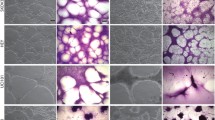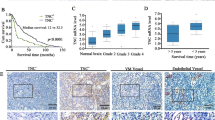Abstract
Tumour vasculogenesis can occur by a process referred to as vasculogenic mimicry, whereby the vascular structures are derived from the tumour itself. These tumours are highly aggressive and do not respond well to anti-angiogenic therapy. Here, we use the well characterised ECV304 cell line, now known as the bladder cancer epithelial cell line T24/83 which shows both epithelial and endothelial characteristics, as a model of in vitro vasculogenic mimicry. Using optimised ratios of co-cultures of ECV304 and C378 human fibroblasts, tubular structures were identifiable after 8 days. The tubular structures showed high levels of TG2 antigen and TG in situ activity. Tubular structures and in situ activity could be blocked either by site-directed irreversible inhibitors of TG2 or by silencing the ECV304 TG2 by antisense transfection. In situ activity for TG2 showed co-localisation with both fibronectin and collagen IV. Deposition of these proteins into the extracellular matrix could be reduced by inclusion of non-cell penetrating TG inhibitors when analysed by Western blotting suggesting that the contribution of TG2 to tube formation is extracellular. Incubation of ECV304 cells with these same irreversible inhibitors reduced cell migration which paralleled a loss in focal adhesion assembly, actin cytoskeleton formation and fibronectin deposition. TG2 appears essential for ECV304 tube formation, thus representing a potential novel therapeutic target in the inhibition of vasculogenic mimicry.







Similar content being viewed by others
Abbreviations
- TG2:
-
Tissue transglutaminase
- TAA:
-
Tumour angiogenic activity
- VEGF:
-
Vascular endothelial growth factor
- FGF:
-
Fibroblast growth factor
- HUVEC:
-
Human umbilical vein endothelial cells
- ECM:
-
Extracellular matrix
- FN:
-
Fibronectin
- DMEM:
-
Dulbecco’s modified Eagles media
- FBS:
-
Fetal bovine serum
- PBS:
-
Phosphate buffered saline
- HRP:
-
Horseradish peroxidase
- DAB:
-
Diaminobenzidine
- FITC:
-
Fluorescein isothiocyanate
- IF:
-
Immunofluorescence
- IHC:
-
Immunohistochemistry
References
Antonyak MA, Li B, Regan AD, Feng Q, Dusaban SS, Cerione RA (2009) Tissue transglutaminase is an essential participant in the epidermal growth factor-stimulated signaling pathway leading to cancer cell migration and invasion. J Biol Chem 284:17914–17925
Bissell MJ (1999) Tumor plasticity allows vasculogenic mimicry, a novel form of angiogenic switch. A rose by any other name? Am J Pathol 155:675–679
Brown J, Reading SJ, Jones S, Fitchett CJ, Howl J, Martin A, Longland CL, Michelangeli F, Dubrova YE, Brown CA (2000) Critical evaluation of ECV304 as a human endothelial cell model defined by genetic analysis and functional responses: a comparison with the human bladder cancer derived epithelial cell line T24/83. Lab Invest 80:37–45
Collighan RJ, Griffin M (2009) Transglutaminase 2 cross-linking of matrix proteins: biological significance and medical applications. Amino Acids 36:659–670
Faye C, Inforzato A, Bignon M, Hartmann DJ, Muller L, Ballut L, Olsen BR, Day AJ, Ricard-Blum S (2010) Transglutaminase-2: a new endostatin partner in the extracellular matrix of endothelial cells. Biochem J 427:467–475
Fujimoto A, Onodera H, Mori A, Nagayama S, Yonenaga Y, Tachibana T (2006) Tumour plasticity and extravascular circulation in ECV304 human bladder carcinoma cells. Anticancer Res 26:59–69
Giatromanolaki A, Sivridis E, Koukourakis MI (2004) Tumour angiogenesis: vascular growth and survival. APMIS 112:431–440
Griffin M, Casadio R, Bergamini CM (2002) Transglutaminases: nature’s biological glues. Biochem J 368:377–396
Griffin M, Mongeot A, Collighan R, Saint RE, Jones RA, Coutts IGC, Rathbone DL (2008) Synthesis of potent water-soluble tissue transglutaminase inhibitors. Bioorg Med Chem Lett 18:5559–5562
Haroon ZA, Hettasch JM, Lai TS, Dewhirst MW, Greenberg CS (1999) Tissue transglutaminase is expressed, active, and directly involved in rat dermal wound healing and angiogenesis. Faseb J 13:1787–1795
Hughes SE (1996) Functional characterization of the spontaneously transformed human umbilical vein endothelial cell line ECV304: use in an in vitro model of angiogenesis. Exp Cell Res 225:171–185
Jones RA, Nicholas B, Mian S, Davies PJ, Griffin M (1997) Reduced expression of tissue transglutaminase in a human endothelial cell line leads to changes in cell spreading, cell adhesion and reduced polymerisation of fibronectin. J Cell Sci 110:2461–2472
Jones RA, Kotsakis P, Johnson TS, Chau DY, Ali S, Melino G, Griffin M (2006) Matrix changes induced by transglutaminase 2 lead to inhibition of angiogenesis and tumor growth. Cell Death Differ 13:1442–1453
Kiessling F, Kartenbeck J, Haller C (1999) Cell-cell contacts in the human cell line ECV304 exhibit both endothelial and epithelial characteristics. Cell Tissue Res 297:131–140
Martinez J, Chalupowicz DG, Roush RK, Sheth A, Barsigian C (1994) Transglutaminase-mediated processing of fibronectin by endothelial-cell monolayers. Biochemistry 33:2538–2545
Nicholas B, Smethurst P, Verderio E, Jones R, Griffin M (2003) Cross-linking of cellular proteins by tissue transglutaminase during necrotic cell death: a mechanism for maintaining tissue integrity. Biochem J 371:413–422
Paulis YW, Soetekouw PM, Verheul HM, Tjan-Heijnen VC, Griffioen AW (2010) Signalling pathways in vasculogenic mimicry. Biochim Biophys Acta 1806:18–28
Ricci-Vitiani L, Pallini R, Biffoni M, Todaro M, Invernici G et al (2010) Tumour vascularization via endothelial differentiation of glioblastoma stem-like cells. Nature 468:824–828
Sane DC, Moser TL, Greenberg CS (1991) Vitronectin in the substratum of endothelial-cells is cross-linked and phosphorylated. Biochem Biophys Res Commun 174:465–469
Suda K, Rothen-Rutishauser B, Gunthert M, Wunderli-Allenspach H (2001) Phenotypic characterization of human umbilical vein endothelial (ECV304) and urinary carcinoma (T24) cells: endothelial versus epithelial features. In Vitro Cell Dev Biol Anim 37:505–514
Telci D, Wang Z, Li X, Verderio EA, Humphries MJ, Baccarini M, Basaga H, Griffin M (2008) Fibronectin-tissue transglutaminase matrix rescues RGD-impaired cell adhesion through syndecan-4 and beta1 integrin co-signaling. J Biol Chem 283:20937–20947
Verderio EA, Johnson T, Griffin M (2004) Tissue transglutaminase in normal and abnormal wound healing: review article. Amino Acids 26:387–404
Wang Z, Collighan RJ, Gross SR, Danen EH, Orend G, Telci D, Griffin M (2010) RGD-independent cell adhesion via a tissue transglutaminase-fibronectin matrix promotes fibronectin fibril deposition and requires syndecan-4/2 and α5β1 integrin co-signaling. J Biol Chem 285:40212–40229
Wang Z, Telci D, Griffin M (2011) Importance of syndecan-4 and syndecan-2 in osteoblast cell adhesion and survival mediated by a tissue transglutaminase–fibronectin complex. Exp Cell Res 317:367–381
Yuan L, Siegel M, Choi K, Khosla C, Miller CR, Jackson EN, Piwnica-Worms D, Rich KM (2007) Transglutaminase 2 inhibitor, KCC009, disrupts fibronectin assembly in the extracellular matrix and sensitizes orthotopic glioblastomas to chemotherapy. Oncogene 26:2563–2573
Acknowledgments
This work is dedicated to Richard Jones who in his prime sadly died of brain cancer. He was both a dedicated scientist and talented artist.
Conflict of interest
The authors declare that they have no conflict of interest.
Author information
Authors and Affiliations
Corresponding author
Rights and permissions
About this article
Cite this article
Jones, R.A., Wang, Z., Dookie, S. et al. The role of TG2 in ECV304-related vasculogenic mimicry. Amino Acids 44, 89–101 (2013). https://doi.org/10.1007/s00726-011-1214-6
Received:
Accepted:
Published:
Issue Date:
DOI: https://doi.org/10.1007/s00726-011-1214-6




